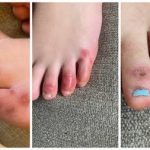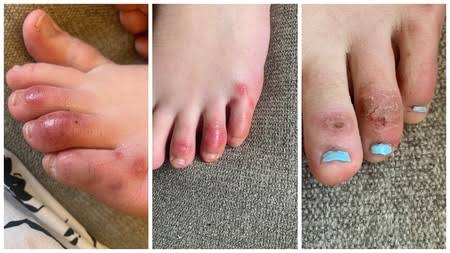COVID toes is the newest of the symptoms that have been reportedly observed in persons suffering from coronavirus.
Doctors treating COVID-19 now say that purple or blue toe lesions appearing on patients’ toes may be a way to diagnose infection, as they have appeared in otherwise asymptomatic and severe cases alike; however, so far there have been no conclusive studies to validate the phenomenon now being called “COVID toes.”

Credit: PennLive
7 Important Facts You Should Know About COVID -19 TOES
1. “They’re typically painful to touch and could have a hot burning sensation,” Dr. Ebbing Lautenbach, chief of infectious disease at the University of Pennsylvania’s School of Medicine told USA Today.
2. Lautenbach said that COVID toes are disproportionately present in children and young adults, who may otherwise be asymptomatic or test negative at early stages of the virus.
3. Intrestingly, the most severe COVID-19 patients also exhibited coronavirus toes, said Susan Wilcox, Massachusetts General Hospital’s chief of critical care for the emergency department, who told USA Todaythat this symptom is most common in patients with acute respiratory distress syndrome (ARDS).
4. There are two possible explanations behind covid toes, according to Lautenbach: It could possibly be a localized inflammatory response to infection that presents in a person’s foot and toes, or, it might be a blood vessel clot—more research would need to be done.
5. Purple and blue lesions on the toes are also present in severe flu or viral pneumonia patients, according to Wilcox.
6. TheAmerican Academy of Dermatologyhas also reportedly begun its own registry of dermatological issues possibly linked with COVID-19–including “COVID toes”—to better understand the link.
7. No conclusive research has been done on coronavirus toes, experts warn, so all explanations and evidence is still anecdotal at this point.
RECAP
The Common symptoms of coronavirus include fever, tiredness, dry cough and some people can experience aches and pains, nasal congestion, runny nose, sore throat, diarrhoea, abdominal pain, malaise and diarrhea—among other symptoms—according to the World Health Organization. It generally takes five to six days from the point of infection for someone to begin presenting symptoms of the disease, though it can take up to 14 days—and some cases are totally asymptomatic. If you experience a fever, cough or difficulty breathing, WHO recommends you seek medical attention immediately while self-isolating.
This article was culled from FORBES with the sole purpose of helping to raise awareness about the new emerging COVID-19 symptoms to the general public especially among all healthworkers who are the front line soldiers in this battle to defeat coronavirus globally.





















